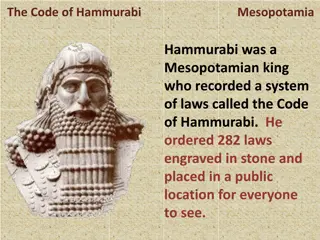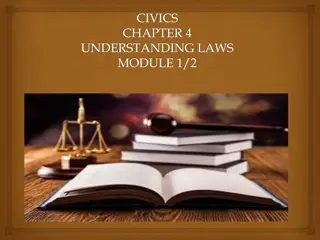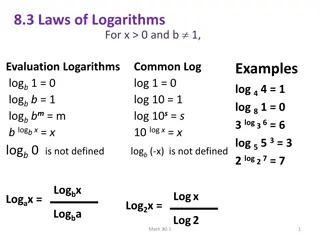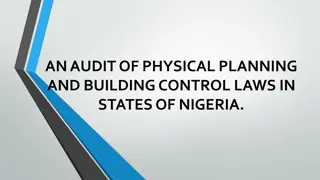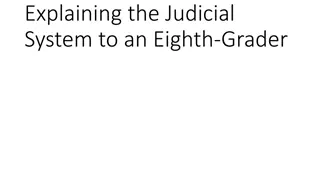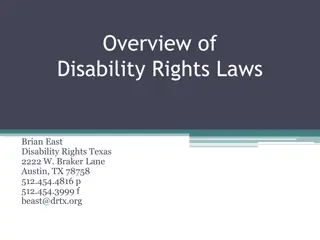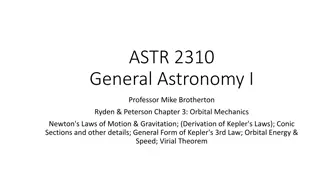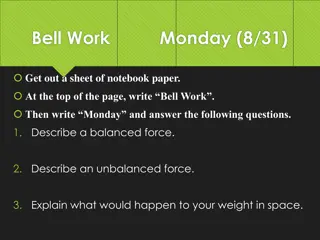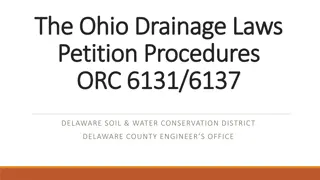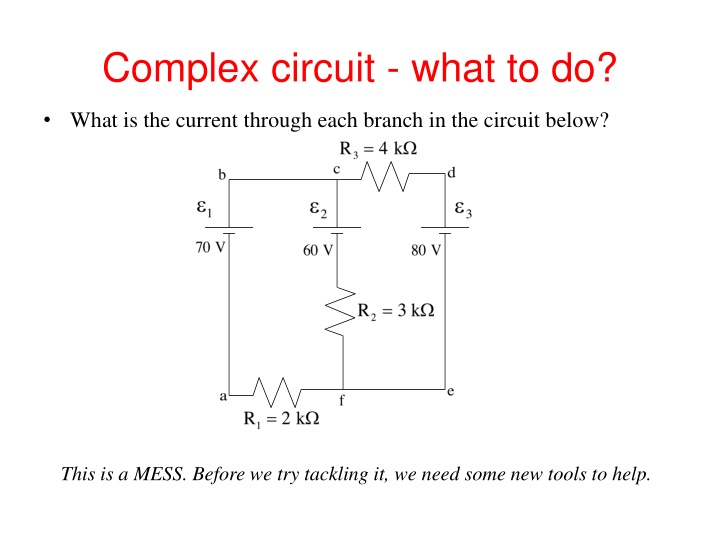
Complex Circuit Analysis with Kirchhoff's Laws
Learn how to analyze complex circuits using Kirchhoff's Laws to determine current flow through each branch. Discover the principles of nodes, branches, currents, and apply loop rules for circuit analysis.
Uploaded on | 0 Views
Download Presentation

Please find below an Image/Link to download the presentation.
The content on the website is provided AS IS for your information and personal use only. It may not be sold, licensed, or shared on other websites without obtaining consent from the author. If you encounter any issues during the download, it is possible that the publisher has removed the file from their server.
You are allowed to download the files provided on this website for personal or commercial use, subject to the condition that they are used lawfully. All files are the property of their respective owners.
The content on the website is provided AS IS for your information and personal use only. It may not be sold, licensed, or shared on other websites without obtaining consent from the author.
E N D
Presentation Transcript
Complex circuit - what to do? What is the current through each branch in the circuit below? This is a MESS. Before we try tackling it, we need some new tools to help.
Complex circuit analysis When faced with a complex circuit (one that can t be easily simplified into a single equivalent resistor), up until now, we ve used the seat of the pants approach -- working piecemeal to figure out parts and eventually getting to an answer. There is a more formal way to do this which we ve actually already sort of been doing! Before going on, though, we need to make sure we re all on the same page with some vocabulary. So What s a node? Junction where branches meet. What s a branch? A connection between nodes What do you know about current(s) at a node? I in = I out What do you know about current in a branch? I is constant in a branch - one path!
Kirchhoffs Laws The formal approach uses two equations that relate current, resistance, and voltage around a circuit. These equations are called Kirchhoff s Laws. Junction (node) rule: the sum of the currents into a junction/node is equal to the sum of the currents out of a junction/node, or ???= ???? Loop rule: around any closed loop of a circuit, the sum of the potential differences across each element must be zero, or ?1+ ?2+ = 0 (where 1, 2, indicate elements in the circuit like resistors or batteries)
Kirchhoffs Laws applied Consider the circuit to the right. How would you start solving this? --Identify the nodes: how many? 2, labeled a and b 3 a --How many different node equations can you write for this circuit? Why? just 1 (same for a and b): 2 1 ?1+ ?3= ?2 --How many branches? 3 (R1 and V; R2; R3 and R4) --Identify the loops: how many? 3, labeled 1, 2, and 3 --How would you use the loop rule for each loop? Loop 1: b Loop 2: Loop 3: ? ?2?2 ?1?1= 0 ?2?2 ?3?4 ?3?3= 0 ? + ?3?3+ ?3?4 ?1?1= 0 Why are these positive?
Loop Rule comments The loop rule tells us that the sum of the potential differences around a closed loop equals zero. That is, if you return to the same spot in a circuit after tracing a closed loop, you should end up at the same potential you started at. We know current flows from higher voltage to lower voltage. Thus, if your loop moves in the same direction as current through a resistor, there will be a voltage drop equal to IR in that resistor. If your loop moves against the current direction in a particular resistor, that just means that your loop shows a voltage increase for that part of the circuit in the direction you are tracing. Current still flows from high V to low V! The biggest thing is to define your currents first and work with them through the problem consistently. If you assumed the wrong current direction, you ll see it in your solution. How ?
Solving a problem with Kirchhoffs Laws So for this circuit, we have 1 node equation and 3 possible loop equations. How many do we actually need to determine the currents? We only need 1 node and 2 loops to solve - we have three unknowns, so we need 3 equations. There will always be one more node and one more loop than there are independent equations! Now what? We can solve simultaneously for the three currents. ?1+ ?3= ?2 ? ?2?2 ?1?1= 0 ?2?2 ?3?4 ?3?3= 0 You should get a negative current for I3as it s drawn here - what does that mean? ? + ?3?3+ ?3?4 ?1?1= 0
General guide to using Kirchhoffs Laws Don t get thrown by the circuit! Ignore meters, crazy connections and shapes, whatever. Take a deep breath. 1. Define and label the current in every branch of the circuit. Remember, a branch starts and ends at a junction. Also remember that if you choose the wrong direction, it will work out. Just choose. 2. Identify the nodes, and use the Junction Rule to write out the node equation for each node. Do this for as many nodes as you can find, unless you re just repeating a previous equation. 3. Identify a closed loop and use the Loop Rule to write out the loop equation. Do this for as many loops as needed to accommodate the number of unknowns you have. 4. Solve simultaneously for the unknowns!
Using Kirchhoffs Laws Here s a circuit you ve seen before: the island problem from 2 weeks ago. Last time, we used seat of our pants to find what the meters read. Now, let s use Kirchhoff s Laws to find all three currents, and therefore what the meters read, and see what we get! V 1 ? 3 ? 10 V 2 ? 4 ? A
Last time: What do each of the meters read? The ammeter reads 3.92 A, so the current through the branch containing the battery and the 1-ohm resistor is 3.92 A. V 1 ? 3 ? The current through the 2 ohm resistor is 3.04 A, and the current through the 7-ohm resistance branch is 0.88 A. 2 ? 4 ? The voltmeter reads ?.?? ? A Did you get the same answers using Kirchhoff s Laws? You should!
Problem 18.20 Find the unknowns using Kirchhoff s Laws
Problem 18.23 (slightly modified) What is the current in each branch? R3= 4 kW c d b What do the meters read? e1= 70v e3= 80v e2= 60v What is the potential difference between points b and f? A R2= 3 kW V e a f R1= 2 kW Solution on class Website
Problem 18.23 R3= 4 kW c i1 + i2+ i3= 0 Node C: d b e1 e2 e3 +R1i1-R2i2+e2-e1= 0 Loop 1: L2 70 V 60 V 80 V R2i2+e3-R3i3-e2= 0 Loop 2: g i1 R2= 3 kW Now what? Solving simultaneously by the substitution method when you have more than 2 or 3 unknowns can be a major pain. Thankfully, there s another way! i2 L1 i3 e a I ll walk through this on the board in class. If you miss it, or need another reference, Mr. Fletcher s typed explanation is posted on the class Website. f R1= 2 kW
Matrix approach in your calculator Once you have your values in matrix form, you can also use your TI calculator to solve the matrix for you! There are two ways to do so: Way #1 is explained in Mr. Fletcher s PDF of solving matrices. Way #2 uses the built-in rref function, which you can find under matrix math rref. To use it: Create a matrix [A] in your calculator that has one line for each equation, and columns for i1, i2, i3 etc, and the last column are your V values. Do rref([A]) and hit enter. The resulting matrix will give you the values for each unknown current!


